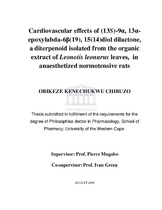Cardiovascular effects of (13S)-9_, 13_- epoxylabda-6_(19), 15(14)diol dilactone, a diterpenoid isolated from the organic extract of leonotis leonurus leaves, in anaesthetized normotensive rats
Abstract
Plants used in traditional medicines have served as sources of some of the drug compounds used in medicines today, and could still serve as leads for then development of new drugs to treat existing chronic diseases such as hypertension. This study was aimed at the isolation and identification of a cardio-active compound from L. leonurus, a plant commonly used in traditional medicines in South Africa for the treatment of hypertension and other cardiac problems. The possible mechanisms by which the isolated compound produced its effect on the cardiovascular system were explored using the anaesthetized normotensive rat model.Fractionation of the organic extracts of the leaves led to the isolation of a novel diterpene,(13S)-9 , 13 -epoxylabda-6 (19),15(14)diol dilactone (EDD) whose structure was elucidated using infra red (IR), nuclear magnetic resonance (NMR), mass spectroscopy(MS), and X-ray diffraction analysis. In anaesthetized normotensive male Wistar rats, EDD(0.5 mg/kg – 5.0 mg/kg; IV) produced slight non-significant decreases in systolic pressure(SP), diastolic pressure (DP), and mean arterial pressure (MAP) with the lower (0.5 mg/kg– 2.0 mg/kg) doses, while significant increases in SP, DP and MAP occurred with the higher (3.0 mg/kg – 5.0 mg/kg) doses. All doses of EDD administered also produced significant decreases in heart rate (HR).Prazosin and reserpine pre-treatment abolished the vasoconstrictive effect of EDD,suggesting an indirect vasoconstrictive effect for EDD via the release of catecholamines.Atenolol pre-treatment led to increases in the negative chronotropic effect of EDD, while the positive chronotropic effect of dobutamine was significantly decreased by EDD,suggesting the involvement of the 1 adrenoceptor in the negative chronotropic effect of EDD. In animals pre-treated with verapamil, a cardio-selective Ca2+ channel blocker, no significant changes in HR occurred with all EDD doses, but HR values were significantly lower than those obtained with EDD in non pre-treated animals.The results of this study indicate that (13S)-9 , 13 -epoxylabda-6 (19),15(14)diol dilactone, a novel dilactone diterpene isolated from the leaves of L. leonurus has an effect on the cardiovascular system. EDD exhibits a dual effect on the cardiovascular system by
producing a vasoconstrictive effect accompanied by bradycardia. The vasoconstrictive effect of EDD is probably due to the release of catecholamines, while the negative chronotropic effect is probably due to 1 adrenoceptor antagonism. Further studies are however required to fully determine the mechanism by which EDD produces its cardiovascular effects.

